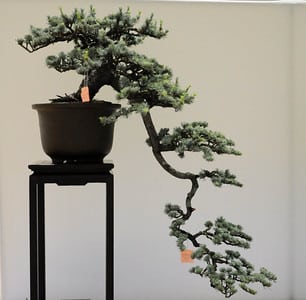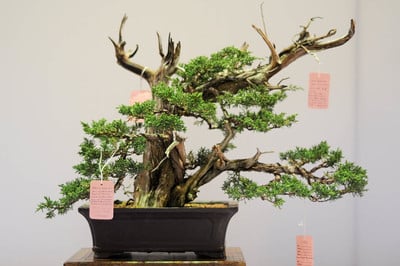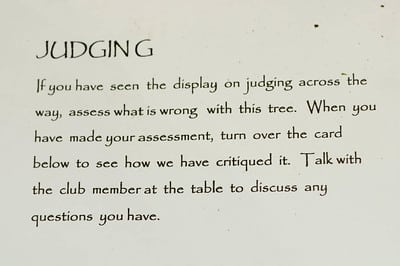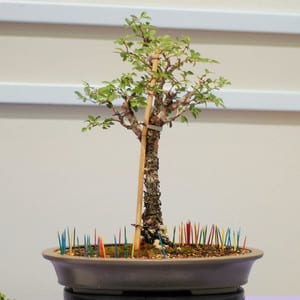The most intriguing new feature of REBS’ 26th Annual Show was its endeavor to teach visitors about judging bonsai. I get excited about educational efforts in this area because I believe they can lead, ultimately, to better trees. Teaching bonsai evaluation is analogous to teaching art or music appreciation – it’s a vehicle for conveying knowledge about what makes bonsai compelling. As REBS’ President, Bob Shimon, explained to me, REBS was more interested in helping visitors recognize merit in a tree than simply showing off blue ribbons and leaving it to the guests to discern why they were awarded. And for a practice in which most educational effort is applied toward the technical aspects of caring for and styling trees, I believe REBS made a good decision.
Some displays were interactive – others were informational. Yasuo Mitsuya, visiting from Japan to provide Saturday’s demonstration for the show, commented on a number of bonsai. His remarks were recorded on evaluation forms that were displayed with the trees so visitors could see how various aspects of the trees “scored.” The evaluation forms included the following criteria: Health, Wiring, Trunk/Nebari, Branches, Potting, and Overall Design and Presentation. Each criteria included a number of sub-points to consider. Potting, for example, included subcategories for Placement in pot/Grove arrangement, Suitability of pot, and Soil level and surface treatment.

REBS Judging Form
Some trees served as object lessons for various teaching points. The blue atlas cedar below was brought to the show in a somewhat rangy state. Sunday’s demonstrator, Kathy Shaner, cleaned up the lower branches so the distinction between the top and bottom of the tree would be clear to visitors.

Blue atlas cedar
Other trees were tagged branch by branch. A small twig at the top right of the tree below read, “Any branch this size should only be 1/4″ to 1/2″ long. All long thin branches would have been broken in the wind and/or burned short in a fire – THINK AGE.” A tag on the left side of the tree mentioned that the branches on this side were long for a tree that predominantly grows to the right.

Tanuki tagged with comments
Interactive displays included opportunities for visitors to do their own judging before comparing their results with critiques by Shaner, Mitsuya and other club members.

An encouraging card
One of the most popular judging attractions was an elm that invited visitors to select a front for the tree. Based on the rainbow of toothpicks it received it appears the jury is still out on this one.

Can you find the front?
The judging exhibits at REBS’ 26th Annual Show got a lot of people to think about judging bonsai. I wholeheartedly appreciate the effort and look forward to seeing similar efforts at next year’s show.
Subscribe to Bonsai Tonight
New Posts Delivered Every Tuesday and Friday
AlexV says
Thanks for posting this Jonas! Kathy and I had talked last year during the REBS show about ways to educate members and the public about refining bonsai and it seems like they have made a great start of it. I also recognized that atlas cedar from the sunset bonsai book on page 98. Its good to see some of the older material in California getting modern styling makeovers, or in this case examples of how to go about reclaiming material that appears to have been neglected.